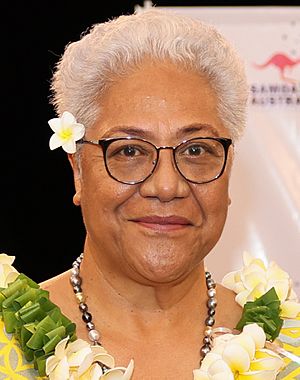Prime Minister of Samoa facts for kids
Quick facts for kids Prime Minister of theIndependent State of Samoa |
|
|---|---|

|
|
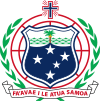
|
|
| Ministry of the Prime Minister and Cabinet | |
| Style | Madam Prime Minister (informal) The Honourable (formal) Her Excellency (diplomatic) |
| Abbreviation | PM |
| Member of |
|
| Seat | Apia |
| Nominator | Political parties |
| Appointer | O le Ao o le Malo |
| Term length | Five years, renewable |
| Constituting instrument | Constitution of Samoa |
| Precursor | Leader of Government Business |
| Inaugural holder | Fiamē Mataʻafa Faumuina Mulinuʻu II |
| Formation | 1 October 1959 |
| Deputy | Deputy Prime Minister of Samoa |
| Salary | US$78,000 annually |
| Website | www.samoagovt.ws |
The Prime Minister of Samoa is the main leader of the government in Samoa. This person is chosen from the Legislative Assembly, which is like Samoa's parliament. The O le Ao o le Malo (Head of State) officially appoints the Prime Minister for a five-year term. Since Samoa became independent in 1962, seven different people have held this important job. The current Prime Minister is Fiamē Naomi Mataʻafa. She became Prime Minister after a disagreement about the 2021 election results was settled by the court.
Contents
History of Samoa's Top Leader
Early Leaders in Colonial Times
The very first person to hold a similar leadership role in Samoa was Albert Barnes Steinberger. He was an American who became Prime Minister in July 1875, appointed by King Malietoa Laupepa. He only held the position for about seven months. British and American officials convinced the King to remove him because they thought he was too close to German business interests. After this, Samoa did not have a Prime Minister for many years. In 1899, Samoa was divided and became colonies of Germany and America.
During World War I, New Zealand took control of the German part of Samoa in 1914. Later, in 1920, it became a territory managed by New Zealand.
Prime Ministers After Independence
The role of Prime Minister officially began in 1959, while Samoa was still a New Zealand territory. The first Prime Minister was a high chief named Fiamē Mataʻafa Faumuina Mulinuʻu II. He started his term on October 1, 1959.
Samoa, then called Western Samoa, gained its independence on January 1, 1962. The Prime Minister's job continued, and Fiamē Mataʻafa Faumuina Mulinuʻu II remained in office. The Head of State, or O le Ao o le Malo, was created as a ceremonial role, meaning it was mostly for show and tradition. In 1991, the parliament changed the term for a Prime Minister from three years to five years. This meant a Prime Minister could serve longer without needing to be re-elected.
From May 24 to July 23, 2021, there was a big disagreement about who was the rightful Prime Minister. This happened after the 2021 general election had a very close result. The two people claiming the role were Tuilaʻepa Saʻilele Malielegaoi, who had been Prime Minister for a long time, and Fiamē Naomi Mataʻafa. Fiamē Naomi Mataʻafa was a former Deputy Prime Minister and the daughter of the first Prime Minister. On July 23, 2021, the Supreme Court decided that Fiamē Naomi Mataʻafa's party, FAST, had been the rightful government since May 24. Tuilaʻepa then accepted the court's decision. This made Fiamē Naomi Mataʻafa Samoa's first female Prime Minister.
How the Prime Minister is Chosen and What They Do
Samoa's Constitution, which is like its rulebook, says that the Head of State (O le Ao o le Malo) has the main power. However, the Head of State acts only on the advice of the government. The Head of State signs new laws and can close down the parliament. The real power is used by the Prime Minister and their cabinet, which is a group of top government officials.
The Head of State chooses the Prime Minister from the Legislative Assembly. The person chosen must have the support of most members in the Assembly. The Legislative Assembly can also remove the Prime Minister from office. This system means Samoa is a parliamentary democracy. This is a type of government where the people elect representatives to a parliament, and the government is formed by the party or group that has the most support in that parliament.
List of Prime Ministers
- Political parties
Human Rights Protection Party (HRPP) Faʻatuatua i le Atua Samoa ua Tasi (FAST)
- Status
Denotes acting prime minister
- Symbols
Died in office
Prime Minister of the Kingdom of Samoa (1875–1876)
| No. | Portrait | Name (Birth–Death) |
Election | Term of office | Political party | Monarch | ||
|---|---|---|---|---|---|---|---|---|
| Took office | Left office | Time in office | ||||||
| 1 | 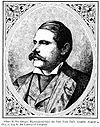 |
Albert Barnes Steinberger (1840–1894) |
— | 22 May 1875 | 8 February 1876 | 262 days | Independent | Laupepa |
| Post abolished (8 February 1876 – 1 October 1959) | ||||||||
Prime Ministers of the Independent State of Samoa (1959–present)
| No. | Portrait | Name (Birth–Death) |
Election (Parliament) | Term of office | Political party | O le Ao o le Malo (Head(s) of state) |
||
|---|---|---|---|---|---|---|---|---|
| Took office | Left office | Time in office | ||||||
| 1 | 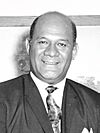 |
Fiamē Mataʻafa Faumuina Mulinuʻu II (1921–1975) |
1961 (1st) 1964 (2nd) 1967 (3rd) |
1 October 1959 | 25 February 1970 | 10 years, 147 days | Independent | Meaʻole & Tanumafili II |
| Tanumafili II | ||||||||
| 2 |  |
Tupua Tamasese Lealofi IV (1922–1983) |
1970 (4th) | 25 February 1970 | 20 March 1973 | 3 years, 23 days | Independent | |
| (1) |  |
Fiamē Mataʻafa Faumuina Mulinuʻu II (1921–1975) |
1973 (5th) | 20 March 1973 | 20 May 1975 | 2 years, 61 days | Independent | |
| — |  |
Tupua Tamasese Lealofi IV (1922–1983) Acting prime minister |
— (5th) | 21 May 1975 | 24 March 1976 | 308 days | Independent | |
| 3 | 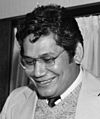 |
Tupuola Efi (born 1938) |
1976 (6th) 1979 (7th) |
24 March 1976 | 13 April 1982 | 6 years, 20 days | Independent | |
| 4 |  |
Vaʻai Kolone (1911–2001) |
1982 (8th) | 13 April 1982 | 18 September 1982 | 158 days | HRPP | |
| (3) |  |
Tupuola Efi (born 1938) |
— (8th) | 18 September 1982 | 31 December 1982 | 104 days | Independent | |
| 5 | 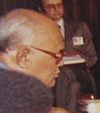 |
Tofilau Eti Alesana (1924–1999) |
— (8th) 1985 (9th) |
31 December 1982 | 30 December 1985 | 2 years, 364 days | HRPP | |
| (4) |  |
Vaʻai Kolone (1911–2001) |
— (9th) 1988 (10th) |
30 December 1985 | 8 April 1988 | 2 years, 100 days | HRPP | |
| (5) |  |
Tofilau Eti Alesana (1924–1999) |
— (10th) 1991 (11th) 1996 (12th) |
8 April 1988 | 23 November 1998 | 10 years, 229 days | HRPP | |
| 6 | 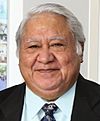 |
Tuilaʻepa Saʻilele Malielegaoi (born 1944) |
— (12th) 2001 (13th) 2006 (14th) 2011 (15th) 2016 (16th) |
23 November 1998 | 24 May 2021 | 22 years, 182 days | HRPP | |
| Tupua Tamasese Efi | ||||||||
| Vaʻaletoʻa Sualauvi II | ||||||||
| 7 |  |
Fiamē Naomi Mataʻafa (born 1957) |
2021 (17th) | 24 May 2021 | Incumbent | 4 years, 208 days | FAST | |
Timeline of Prime Ministers

More to Explore
- Samoa
- Politics of Samoa
- O le Ao o le Malo (Samoa's Head of State)
- Deputy Prime Minister of Samoa
See also
 In Spanish: Primer ministro de Samoa para niños
In Spanish: Primer ministro de Samoa para niños


